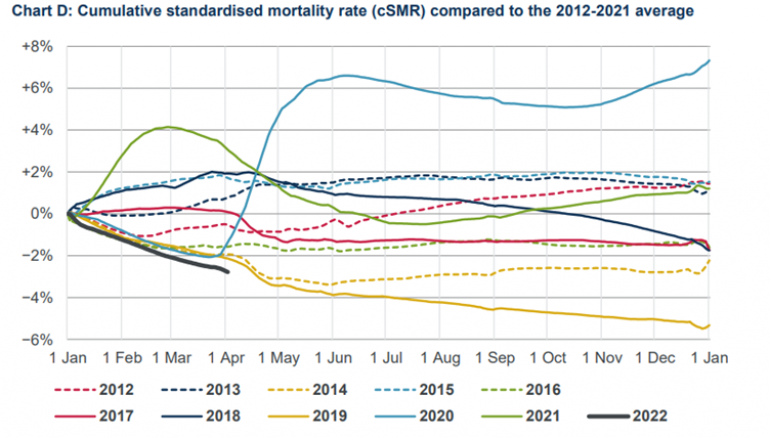In his latest blog, Douglas Anderson examines the cumulative standardised mortality rate of 2022 in comparison to the averages over the last decade.

The cumulative 2022 figures – relative to the average over the last decade - are shown by the black line in the chart. According to the CMI, the start to 2022 is the “record best”. This bodes well for a strong rebound in period life expectancy in 2022.
Surprised? With so many people in your personal circles testing positive, it’s natural to assume that mortality rates must remain elevated. But, the emerging statistics tell a more reassuring story.
Making sense of the recent past
In the first quarter of 2022, the UK experienced an explosion of COVID cases as social distancing measures were gradually relaxed. That public health decision was, however, taken on the back of COVID becoming less dangerous than it was two years ago.
Media sites continue to report that large numbers of people die with COVID, but it seems increasingly rare that death occurs because of COVID. Statistics show that there are many people in hospital with COVID, but not because of COVID. What we are seeing is the COVID has completed its journey from starting as an epidemic, spreading out into a dangerous pandemic to now being a largely manageable endemic.
When COVID first struck, the disease was materially more dangerous (a death rate of something like 10x flu). With vaccinations, changes to the way we live our lives, better treatments and the emergence of less deadly dominant variants, the risk of death has thankfully reduced.
Indeed the pace at which we have worked through those phases is a testament to the skill and sophistication of modern scientific techniques: in developing tests, understanding human behaviours, statistical modelling, developing vaccinations and safe treatments.
The patterns in North America are following a similar trajectory to the UK. But the picture in China is very different with Shanghai in lockdown. It’s a good reminder that despite the improvement, we have not reached “herd immunity”, and some experts argue that we probably never will.
Possible leading indicators for the long term
Actuaries projecting pension liabilities are more interested in long-term trends, which are more material for pension reserves than the elevated mortality of the last two years.
Taking the UK’s COVID response as a case study, what has changed? I spotted four things that could become leading indicators of the long-term:
- Waiting times for health treatments have lengthened: According to LCP, since 2018 the number of people in England on a waiting list has risen from 4m to 6m, and the average wait time has almost doubled from 7 weeks to 13 weeks. This is arguably not news and certainly not all down to COVID: waiting times had been lengthening as the NHS budget struggled to keep pace with the growing health needs of an ageing population over the last decade. That leads to points 2 and 3.
- More public money going into NHS: The COVID crisis has provided the political cover to enable the Government to push through a long-needed tax rise, specifically earmarked for health services, at a challenging time for household budgets (with rising heating and food prices). The health and social care levy will raise £12bn a year. That sounds like a lot of money, but central government’s NHS budget is around the £150bn mark, and that excludes the social care component that is provided by local authorities, so the rise is well under 10% in percentage terms. That’s useful money at the margin, but could be quickly used up by the continued ageing of the population.
- Labour shortages are encouraging employers to prioritise employee well-being: COVID continues to cause a big shake out in working practices. Trade unions highlight the loss of 200,000 older workers, reversing a previously healthy trend in employment levels in older people. Further, workers show little appetite to return to a daily commute to the office, after showing that the job can be done perfectly well from home: “hybrid working” – part office-based, part home-based looks like it will be the “new normal” for those whose jobs are suitable. Employers are increasingly appreciating that they will need to invest more in health and wellbeing to attract and retain older employees. This emphasis on prevention in middle aged workers is very welcome. By focussing on slowing down ageing by improving lifestyle, it is possible to soften the demands of the ageing population on future treatment in the NHS system.
- More private money going into genetic research: COVID showcased the first mass benefit of the genetics research industry (mRNA vaccines), leading to sharp share price gains for the visionary investors. This stunning success is encouraging other investors to back the biotechnology sector. The increase in research capacity bodes well for the volume of future advances. Take a look at the Deep Knowledge Group to see the growing coalition of researchers and investors.
So, my personal sample of emerging themes offers three positive, but slow, improvements from three different stakeholder groups: government, employers and investors. Collectively, these may turn out to be more significant for pensioner longevity – when the inevitable peaks and troughs from year to year are smoothed out - than today’s spike in waiting lists for treatments. On a personal level, I certainly hope so.
What do you think? Do you see other reasons why the past may not be a guide to the future? When we look back in 20 years’ time at the COVID crisis, do you think we will see it as a catalyst for faster or slower longevity gains?
Douglas Anderson FIA CERA FSA
Douglas is the Founder and Chief Visionary Officer of Club Vita, specializing in applying modern data science techniques to innovate in longevity and mortality risk management. Douglas has a background in pension consulting in which he has over 30 years of experience leading to the creation of Club Vita to solve many of the problems he encountered with his clients.




